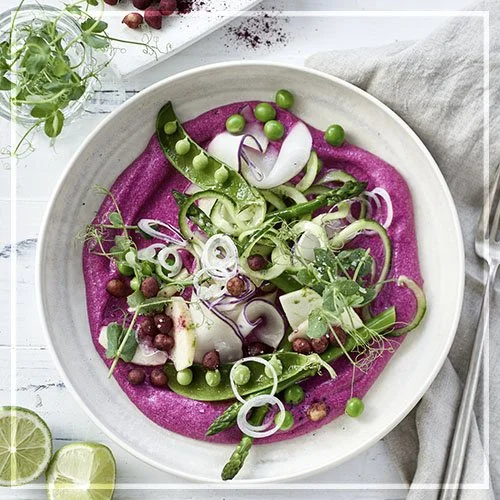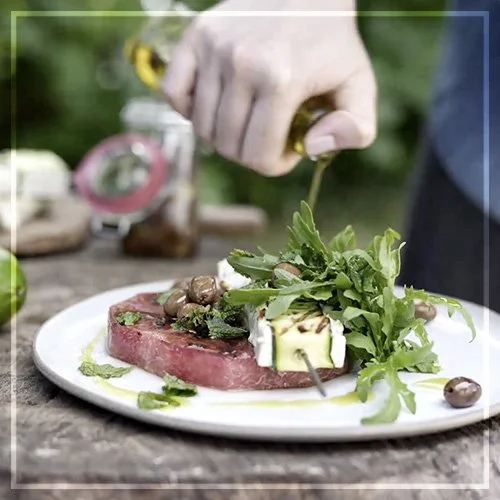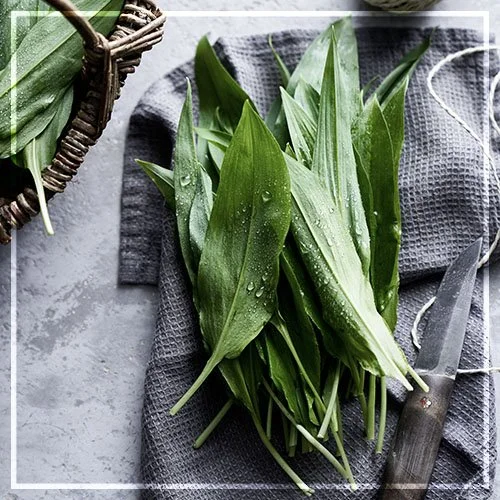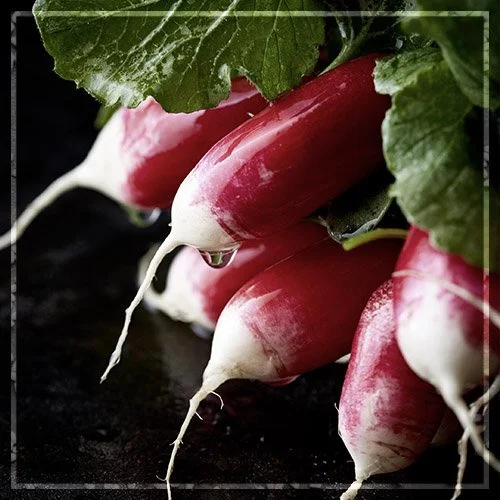.... In Season: Onions .. In Season: Zwiebeln ....
....
Photos: Jan-Peter Westermann
Recipe: Maik Schacht
Text: Sebastian Schubbe
..
Fotos: Jan-Peter Westermann
Rezept: Maik Schacht
Text: Sebastian Schubbe
....
....
What is the first thing that occurs to you?
..
Was fällt euch als erstes dabei ein?
....
....
Correct. Nobody wants to slice onions due to the resulting teary eyes. The sky is blue, water is wet, Marvel is better than DC and slicing onions makes your eyes tear up. Facts of life.
But why do we cry when we slice onions?
We cry because with every cut we make, an enzyme called alliinase, released from compartments within each cell, comes into contact with a compound from the outer cell region, which is called isoalliin.
This process results in the production of an irritant that our body then tries to drown in tears.
We start crying. Excessive mucus as well as swollen eyes are part and parcel of this glorious programme.
If you are clever and slightly sadistic, you may exploit this chemical reaction to your own advantage. A few weeks ago, we had a task at school in which we had to convey emotions through a photograph. So, as one does, we let one of our classmates slice an onion before taking his picture.
Lo and behold: only a few moments after slicing the onion, water was running down his cheeks like it does during one of Hamburg’s very frequent rainstorms. If you then combine those tears with a sad face, anyone can see that the picture does not reflect any happy emotions. I’m sure that Robert De Niro and Leonardo Di Caprio use the same technique.
Since that story doesn’t help us with our problem, I decided to ask around at the studio to find out the best technique to prevent tears from flowing. First things first: having water in your mouth doesn’t work. It will only make you look like a suicidal lemming fidgeting with a knife.
Some people don’t want to renounce this liliaceous plant of Asian origin because they appreciate its antiseptic qualities, its nutritional properties or even just its downright fantastic flavour. For such as these, I have compiled some winning strategies.
In order to figure out the best technique to avoid tears when slicing an onion, I asked around at the studio. Sadly, the resulting answers weren’t always what I had hoped for. I was left with a dangerous smattering of knowledge such as “Hold your breath!” or “Eat the whole thing at once.”
The most important thing you can do is to use a sharp knife, says a cook who listened into the conversation from the kitchen. It is important to do this, as the above-mentioned cell structure is damaged less and thus less isoaliin comes into contact with the alliinase, resulting in fewer irritants.
When preparing the onion, you should make sure not to remove too much of the peel, as this is where most of the nutrients are formed.
After reading this text, you probably have a strong urge to try out a new onion recipe. That’s why we have listed two tasty recipes in which onions are the main ingredient and thanks to our genius cook, you will also be guaranteed a tear-free experience cooking them.
..
Ja, richtig. Dass sie wegen der tränenden Augen keiner schneiden möchte. Der Himmel ist blau, Wasser ist nass, Marvel ist besser als DC und beim Zwiebeln schneiden gibt es halt Tränen. Facts of life.
Aber warum weinen wir beim Zwiebeln schneiden?
Wir weinen, weil beim Schnitt mit dem Messer durch die Zellstruktur diese verletzt wird, sodass sich das Isoalliin der äußeren Zellschicht mit dem Enzym Alliinase aus dem Inneren der Zelle vermischt. Hierbei entsteht ein Reizstoff, welcher unser Körper durch Tränen auszuschwämmen versucht.
Wir heulen. Rotz und geschwollene Augen inklusive, das volle, glorreiche Programm.
Wenn man schlau ist und vielleicht auch ein bisschen sadistisch veranlagt, kann man das jedoch auch für sich nutzen. Vor einigen Wochen bekamen wir in der Berufsschule die Aufgabe, Emotionen auf unseren Bildern zu vermitteln. Also haben wir, was läge näher, einen Mitschüler vor dem Fotografieren eine Zwiebel schneiden lassen.
Und siehe da: Kurz darauf lief das Wasser schon seine Wange hinunter, wie in Hamburg beim besten (Regen-)Wetter.
Kombiniert man die Tränen dann mit einem weinerlichen Blick, kann jeder Mensch eindeutig sehen, dass hier keine fröhliche Stimmung transportiert werden soll. Ich bin mir sicher Robert De Niro and Leo Di Caprio machen es auch genauso.
Da uns diese Geschichte jedoch nicht bei der Lösung des Problems hilft, hab ich im Studio bei allen nachgefragt, welche Technik die Beste ist.
Vorab gesagt: Wasser in den Mund nehmen funktioniert nicht, man sieht dabei nur wie ein suizidgefährdeter Lemming aus, der gerade mit einem Messer rumfuchtelt.
Für die Leute, die trotz erschwerter Handhabung nicht auf dieses aus Asien stammendem Liliengewächs verzichten möchten – sei es wegen seiner stark antiseptischen Wirkung, seiner Nahrhaftigkeit oder einfach, weil sie sau lecker schmecken: Für Euch hab ich hier die richtigen Strategien gesammelt.
Um herauszufinden, welche Technik die Beste ist, Tränen beim Zwiebel schneiden zu vermeiden, habe ich im Studio herumgefragt. Leider ist dabei nicht viel herausgekommen, außer gefährliches Halbwissen und besonders smarte Sätze wie „Luft anhalten!“ oder „Im Ganzen essen.“
Am wichtigsten aber ist, ein scharfes Messer zu verwenden, erzählt der Koch, der aus der Küche die Gespräche mitgehört hat.
Das funktioniert, da so die oben erwähnte Zellstruktur weniger verletzt wird und sich somit auch weniger Isoalliin mit der Alliinase verbindet, wodurch dann auch kaum Reizstoffe entstehen. Bei der Zubereitung der Zwiebel sollte man darauf achten, nicht zu viel der Schale zu entfernen, da sich, wie bei vielen Gemüsesorten, dort die meisten Nährstoffe befinden.
Während des Lesens habt Ihr hoffentlich total Lust auf ein Zwiebel-Rezept bekommen. Darum haben wir hier gleich zwei leckere Rezepte, bei denen Zwiebeln einen großen Teil des Gerichts ausmachen. Dank unseres klugen Kochs klappt die Zubereitung jetzt auch tränenfrei.
....
....
Goat’s Cheese and Onion Flatbread
(For 4-6 servings)
300g flour
1 tsp. dry yeast
1 tsp. salt
11/2 tsp. sugar
125ml lukewarm water
3 tablespoons olive oil
250g sour cream, 24%
400g goat cheese roll
4 red onions
1 handful of thyme
Olive oil to drizzle
Mix flour, yeast, salt and sugar in a bowl and add water and olive oil to form a smooth dough. After kneading, let the dough rest for about half an hour. On a floured surface, roll out the dough to form a round, flat shape with a diameter of 40cm. Place on a baking sheet lined with baking paper. Spread the sour cream evenly on the dough leaving an edge of 4cm. Slice the goat’s cheese and place it on the dough. Then slice the onions into thin slices and evenly spread them out on the dough. Sprinkle the thyme leaves on top and add salt and pepper to taste. Fold the edge over. Sprinkle the bread with olive oil and then bake in a preheated oven at 200°C for about 20 to 25 minutes.
..
Ziegenkäse Zwiebel Fladen:
(für 4-6 Personen)
300g Mehl
1 Tl Trockenhefe
1 Tl Salz
1 Prise Zucker
125ml lauwarmes Wasser
3 El Olivenöl
250g Schmand, 24%
400g Ziegenkäserolle
4 rote Zwiebeln
1 Handvoll Thymian
Olivenöl z. Beträufeln
Mehl mit Trockenhefe, Salz, Zucker in einer Schüssel mischen, mit Wasser und Öl zu einem geschmeidigen Teig kneten. Abgedeckt ½ Stunde ruhen lassen. Auf einer bemehlten Fläche zu einem runden Fladen von ca. 40cm Durchmesser ausrollen. Auf ein mit Backpapier ausgelegtes Backblech legen. Den Teig mit Schmand bestreichen, dabei einen 4 cm breiten Rand frei lassen. Ziegenkäse in Scheiben schneiden und darauf verteilen. Zwiebeln ebenfalls in dünne Scheiben schneiden und verteilen. Thymianblättchen darüber streuen, mit Salz, Pfeffer würzen, den Rand umklappen. Mit Olivenöl beträufeln und im vorgeheizten Ofen bei 200°C ca. 20-25 Min. backen.
....
....
Rainbow trout Ceviche:
(For 4 servings)
1 rainbow trout, ca. 800-1000g
The juice of 2 limes
2 tbs. raspberry vinegar
1 tsp. crushed mustard seeds
2 tsp. brown sugar
6 tbs. olive oil
2 red onions
1 gherkin
Watercress to garnish
Salt, pepper
Filet the trout and remove the fish bones or buy a prepared filet from your trusted fish merchant. Slice the filet into thin slices. Use a mandoline to slice the gherkin and onion into fine slices.
Alternately place the thin slices of trout, onion and gherkin on a plate in a decorative arrangement. Mix the lime juice, vinegar, mustard seeds, sugar, salt, pepper and oil to create a vinaigrette and drizzle it onto the dish. Garnish with fresh watercress and serve immediately.
..
Regenbogenforellen Ceviche:
(für 4 Personen)
1 Regenbogenforelle, ca. 800-1000g
Saft v. 2 Limetten
2 El Himbeeressig
1 Tl Senfkörner, zerstossen
2 Tl brauner Zucker
6 El Olivenöl
2 rote Zwiebeln
1 Frühstücksgurke
Kresse zum Garnieren
Salz, Pfeffer
Forelle filettieren, Gräten ziehen und häuten oder beim Fischhändeler fertiges Filet kaufen. Fischfilet in sehr dünne Scheiben schneiden. Zwiebeln und Gurke auf einem Küchenhobel in sehr feine Scheiben hobeln. Filetscheiben, Zwiebel und Gurkenscheiben abwechselnd dekorativ auf Teller verteilen. Aus Limettensaft, Essig, Senfkörnern, Zucker, Salz, Pfeffer und Öl eine Vinaigrette rühren und Alles damit bertäufeln. Mit frischer, roter Shiso Kresse bestreuen und sofort servieren.
....



































